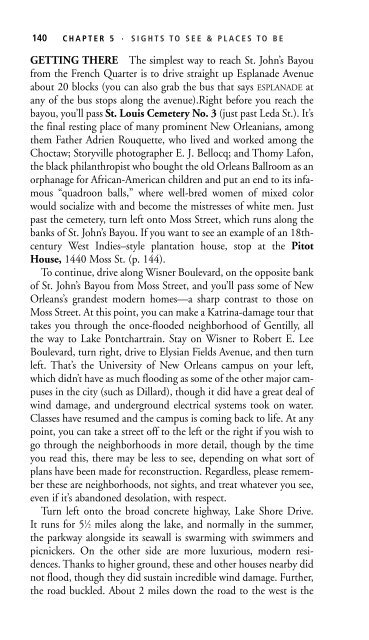You also want an ePaper? Increase the reach of your titles
YUMPU automatically turns print PDFs into web optimized ePapers that Google loves.
140<br />
CHAPTER 5 . SIGHTS TO SEE & PLACES TO BE<br />
GETTING THERE The simplest way to reach St. John’s Bayou<br />
from the French Quarter is to drive straight up Esplanade Avenue<br />
about 20 blocks (you can also grab the bus that says ESPLANADE at<br />
any of the bus stops along the avenue).Right before you reach the<br />
bayou, you’ll pass St. Louis Cemetery No. 3 (just past Leda St.). It’s<br />
the final resting place of many prominent <strong>New</strong> Orleanians, among<br />
them Father Adrien Rouquette, who lived and worked among the<br />
Choctaw; Storyville photographer E. J. Bellocq; and Thomy Lafon,<br />
the black philanthropist who bought the old <strong>Orleans</strong> Ballroom as an<br />
orphanage for African-American children and put an end to its infamous<br />
“quadroon balls,” where well-bred women of mixed color<br />
would socialize with and become the mistresses of white men. Just<br />
past the cemetery, turn left onto Moss Street, which runs along the<br />
banks of St. John’s Bayou. If you want to see an example of an 18thcentury<br />
West Indies–style plantation house, stop at the Pitot<br />
House, 1440 Moss St. (p. 144).<br />
To continue, drive along Wisner Boulevard, on the opposite bank<br />
of St. John’s Bayou from Moss Street, and you’ll pass some of <strong>New</strong><br />
<strong>Orleans</strong>’s grandest modern homes—a sharp contrast to those on<br />
Moss Street. At this point, you can make a Katrina-damage tour that<br />
takes you through the once-flooded neighborhood of Gentilly, all<br />
the way to Lake Pontchartrain. Stay on Wisner to Robert E. Lee<br />
Boulevard, turn right, drive to Elysian Fields Avenue, and then turn<br />
left. That’s the University of <strong>New</strong> <strong>Orleans</strong> campus on your left,<br />
which didn’t have as much flooding as some of the other major campuses<br />
in the city (such as Dillard), though it did have a great deal of<br />
wind damage, and underground electrical systems took on water.<br />
Classes have resumed and the campus is coming back to life. At any<br />
point, you can take a street off to the left or the right if you wish to<br />
go through the neighborhoods in more detail, though by the time<br />
you read this, there may be less to see, depending on what sort of<br />
plans have been made for reconstruction. Regardless, please remember<br />
these are neighborhoods, not sights, and treat whatever you see,<br />
even if it’s abandoned desolation, with respect.<br />
Turn left onto the broad concrete highway, Lake Shore Drive.<br />
It runs for 5 1 ⁄2 miles along the lake, and normally in the summer,<br />
the parkway alongside its seawall is swarming with swimmers and<br />
picnickers. On the other side are more luxurious, modern residences.<br />
Thanks to higher ground, these and other houses nearby did<br />
not flood, though they did sustain incredible wind damage. Further,<br />
the road buckled. About 2 miles down the road to the west is the


